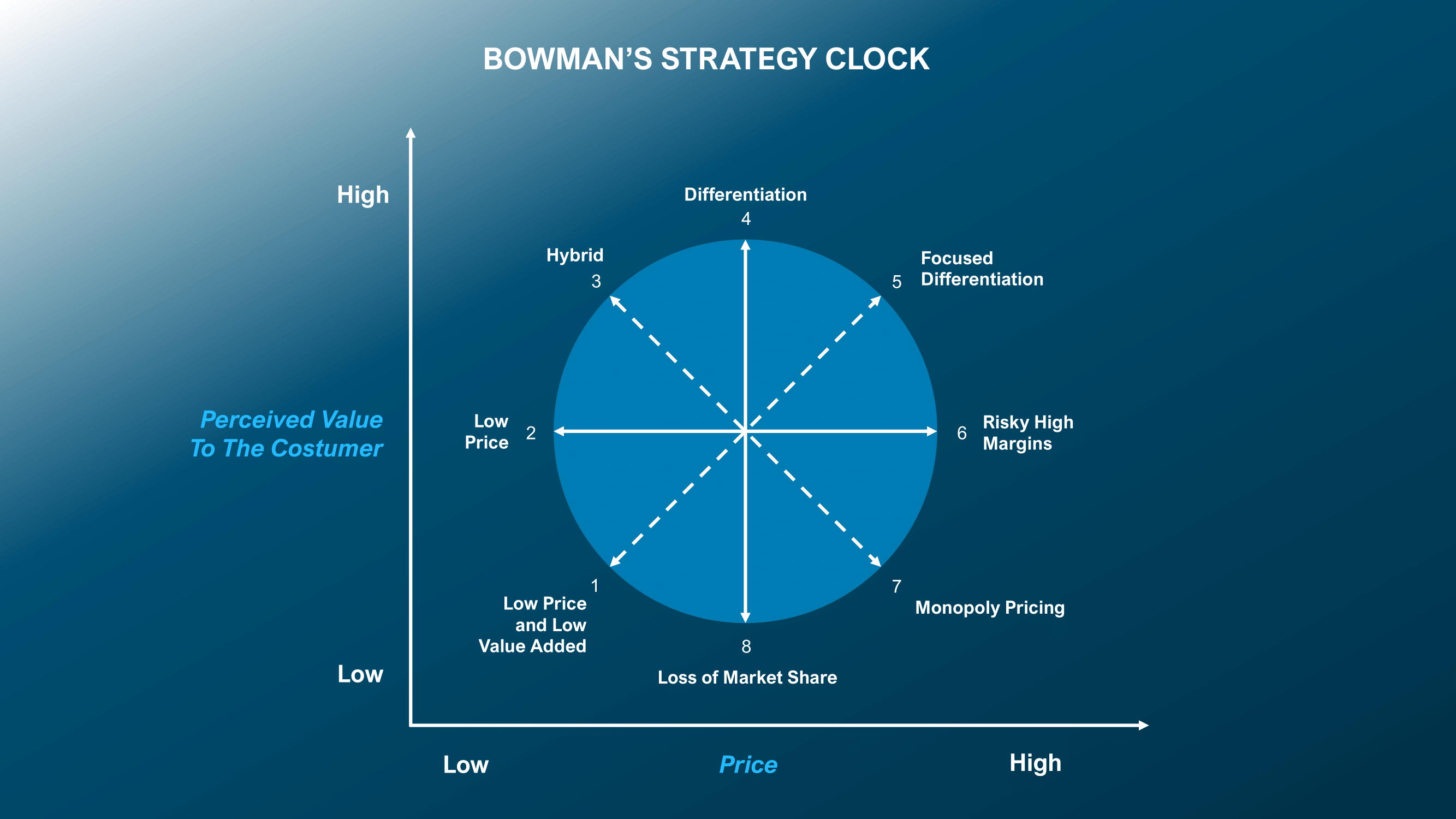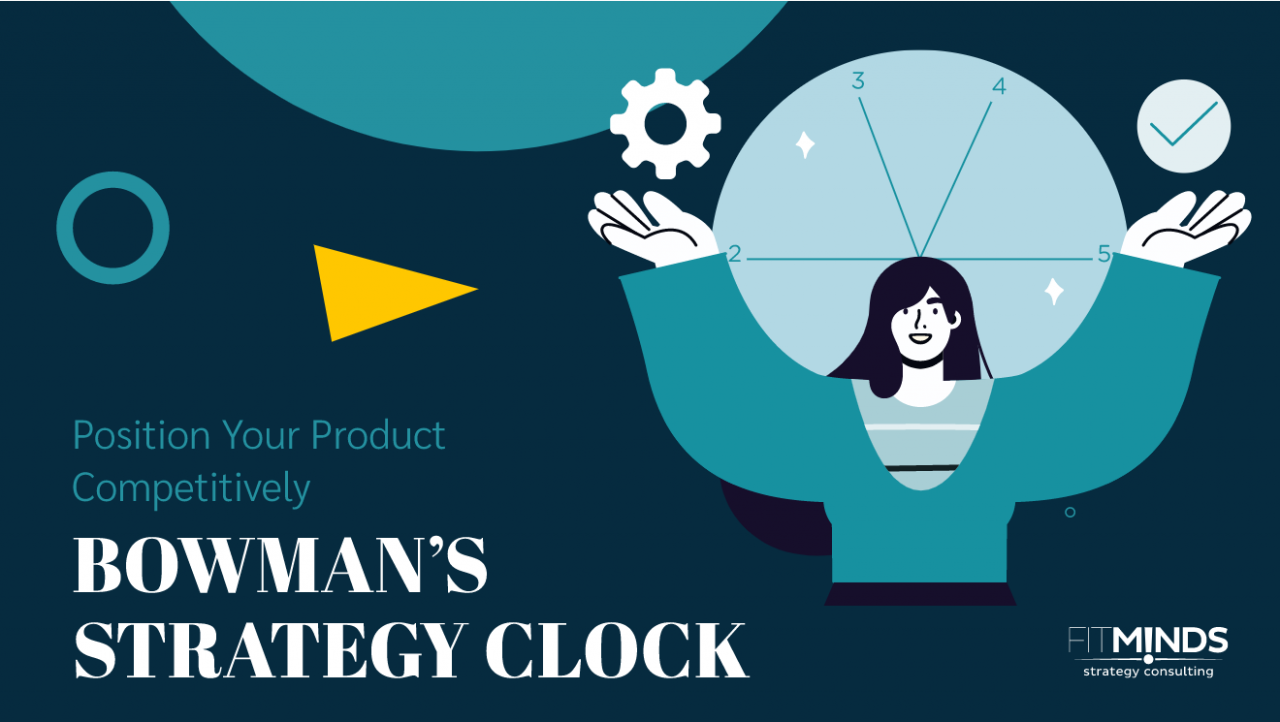Bowman’s Strategy Clock is developed by Cliff Bowman and David Faulkner to create a comprehensive and user-friendly tool that guides businesses in finding their strategic positioning within a market. The tool can be viewed as an alternative to or an extension of Porter’s Generic Strategies, and it is frequently used with tools like the Ansoff Matrix.
Main Benefits of Bowman’s Strategy Clock
Bowman’s Strategy Clock helps you:
- Choose a strategic approach to succeed in a market
- Analyze your position in the market
- Offer a range of starting points to discuss strategy
Explanation Of Bowman’s Strategy Clock
Strategy Clock is for businesses that need to formulate a marketing strategy to achieve a competitive advantage in the market. The Clock consists of 2 fundamental dimensions: price and perceived value of the product. After businesses choose their competition area, different combinations across these 2 dimensions create 8 strategy positions.

Any business can use the Strategy Clock and find its positioning in the market. After evaluating the current situation, strategic alterations can be made to achieve a more competitive position across competitors. The last 3 positioning differs from others since they are not feasible strategies in competition.
How to Apply Bowman’s Strategy Clock
A firm can choose the following positions to attain the highest competitive advantage.
1- Low Price and Low Value-Added
When the product and service give customers the least value-added, a firm must keep its price low to keep up with the competition. Use Van Westendorp’s Price Sensitivity Meter; to determine customers’ optimal price interval while choosing the lowest price possible. Selling large volumes is the key to this positioning.
2- Low Price
Market leaders who reached economies of scale could choose this positioning. In this strategy, the stress is on minimizing the costs and producing large quantities.
3- Hybrid (Moderate Price/Moderate Differentiation)
This strategic position requires product differentiation, which increases the value-added in the minds of consumers. Attaining reasonable prices with differentiation persuades customers that they are being supplied a high-quality product at a competitive price. Use the Five Product Levels to guide your differentiation efforts.
4- Differentiation
Reaching the highest value-added possible is the key to this strategy. Businesses must offer the highest quality possible for their product and service. Think about the Unique Selling Proposition of your business to make your brand stand out.
5- Focused Differentiation
This strategy is to position a high-value product or service at the maximum price, where customers buy or use it because they think it has a high perceived value. Since segmenting customers is a key to this positioning, use RFM Analysis & Segmentation to increase customer loyalty.
6- Risky High Margins
In this approach, the business sets high prices without providing anything more in terms of perceived value. The returns may be substantial if customers keep buying the services or goods at massive costs. This is often a short-term tactic to exploit a fleeting supply imbalance in the market.
7- Monopoly Pricing
Monopolies are less concerned with pricing or perceived consumer value. The company’s products are dependent on the consumer. As a result, monopoly pricing considers the worth of the client, and the consumer has few other options. The monopolist, in principle, has the power to decide on the price. Buyers have the opportunity to purchase the goods or not.
8- Loss of Market Share
This positioning targets a product with low perceived value but hugely disproportionate prices. It is unlikely to charge a typical or mid-range price for a service or item with low perceived value. Typically, this approach includes pricing an inferior product to meet the value proposition of superior competitors or alternative offerings.
Additional Tips and Readings
- OHMAE’S 3CS MODEL helps you to build a sustainable competitive advantage over competitors,
- To visualize customers’ perceptions of different brands concerning different attributes, use Perceptual Mapping,
- To focus on the most critical aspects of strategic planning, use Lafley and Martin’s FIVE-STEP STRATEGY MODEL.
Contact us to assist your businesses in highlighting an alternative approach by using Bowman’s Strategy Clock.


